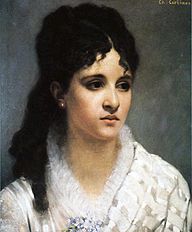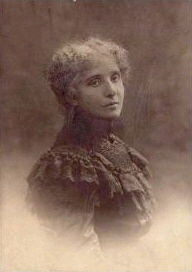Mélanie Bonis facts for kids
Mélanie Hélène Bonis, known as Mel Bonis (born January 21, 1858 – died March 18, 1937), was a talented French composer. She lived during the late Romantic period in music. Mel Bonis wrote over 300 musical pieces. These included music for piano, organ, and groups of instruments (chamber music). She also wrote songs (called mélodies), music for choirs, a mass, and pieces for a full orchestra. She studied at the Paris Conservatoire. Her teachers there included famous composers like Cesar Franck.
Contents
Life Story of Mel Bonis
Mel Bonis was born in Paris to a family that was not rich. She grew up with strict Catholic rules. Mel was very musical and taught herself to play the piano. At first, her parents did not want her to pursue music. But when she was twelve, a professor from the Conservatoire convinced them. This allowed her to start formal music lessons.
In 1874, at age sixteen, she began studying at the Conservatoire. She took classes in accompaniment, harmony, and composition. She studied alongside other future famous composers like Claude Debussy and Gabriel Pierné. César Franck was one of her teachers. It was hard for women to become composers back then. So, she started using the name "Mel," which sounded more neutral than "Mélanie."
While at the Conservatoire, she met Amédée Landély Hettich. He was a student, poet, and singer. Mel fell in love with him and even set some of his poems to music. However, her parents did not approve of their relationship. They made her leave the Conservatoire.
In 1883, when she was twenty-five, her parents arranged for her to marry Albert Domange. He was a businessman, twenty-two years older than her. He had already been married twice and had five children. After getting married, Bonis focused on her home life. She had three children with Domange: Pierre, Jeanne, and Édouard. Her marriage was not ideal because Domange did not like music.
In the 1890s, Bonis met Hettich again. By then, he was a respected vocal teacher and writer about music. He was also married. Hettich encouraged Bonis to start composing again. He helped her connect with important music publishers. After this, her music career began to grow. Bonis and Hettich had a child together, Madeleine, born in 1899. Madeleine was raised by a former housekeeper. She also inherited musical talent from her parents.
Bonis then put all her energy into writing music. Her piano quartet was performed in 1901. When he heard it, the famous composer Saint-Saëns was very impressed. He said he never thought a woman could write such music! In 1905, she received an "honourable mention" for one of her pieces. In 1907, she joined the committee of the Société des compositeurs de musique. From 1910 to 1914, she was its secretary. Some of her works were published by a well-known company, Éditions Alphonse Leduc.
In 1912, after his wife passed away, Hettich confirmed he was Madeleine's father. Domange died in 1918. Bonis then took care of Madeleine, whose foster mother had also died. Later, a family secret about Madeleine's birth had to be revealed. In 1923, Madeleine married Pierre Quinet.
Mel Bonis was a very humble person and did not promote herself much. Even her fans at the time sometimes overlooked her talent because she was a woman. After World War I, her music became less known. She also became ill with arthritis and had to stay in bed. She continued to compose music into the late 1920s. She passed away in 1937 at the age of 79. Hettich died a month later. Bonis is buried in Cimetière de Montmartre in Paris.
In 1974, her daughter, Jeanne Brochot, published a book of Bonis's personal thoughts. It was called "Souvenirs et Réflexions."
Compositions
Chamber Music
- Suite en trio, for flute, violin, and piano, Op. 59 (1903)
- Fantaisie en septuor, for 2 flutes, 2 violins, viola, cello, and piano, Op. 72 (1906)
- Scènes de la forêt, for flute, horn, and piano, Op. 123 (1928)
- Suite dans le style ancien, for flute, violin, and piano, Op. 127 No. 1 (1928)
- Suite orientale, Op. 48
- Le Mourin, Op. 191
- Soir, matin, for violin and piano
- Nocturne
- L'Oiseau bleu Op. 74
- Quatuor pour piano et cordes en si bémol, Op. 69 (Piano Quartet in B flat)
- Quatuor pour piano et cordes en ré, Op. 124 (Piano Quartet in D)
- Flute Sonata in C-sharp minor, Op. 64
- Madrigal for voice and piano, Op. 53
- Cello Sonata in F major, Op. 67
- Violin Sonata in F sharp minor, Op. 112
- More pieces for violin and piano, and flute and piano
Music for Piano
A modern collection of her piano music is published in nine volumes:
- First volume: Femmes de légende (Legendary Women)
- Second and third volumes: Pièces pittoresques et poétiques (Picturesque and Poetic Pieces), I and II
- Fourth volume: Concert pieces
- Fifth volume: Danses et pièces légères (Dances and Light Pieces)
- Sixth volume: Piano à quatre mains A (Piano Four Hands A)
- Seventh volume: Pièces pittoresques et poétiques III
- Eighth volume: Piano à quatre mains B (Piano Four Hands B)
- Ninth volume: Deux pianos à quatre main, Scherzo Op. 40 and Variations Op. 85 (Two Pianos Four Hands)
Children's Music
- Children's Scenes, Op. 92 (1912)
- Miocheries, Op. 126 (1928)
- Neuf Pièces faciles, Op. 148 (1936) (Nine Easy Pieces)
- 17 Pièces enfantines, Op. 116 (1926) (17 Children's Pieces)
- Album pour les tout petits, Op. 103 (1913) (Album for the Very Young)
Organ Music
- L'Œuvre pour orgue, 27 pieces, including Toccata, Cantabile, Choral, and more.
Vocal Religious Music
- Regina Cœli, Op. 45
- Cantique de Jean Racine
- Messe à la Sérénité (Mass of Serenity)
- Many motets like Adoro te, Inviolata, etc.
Orchestra Music
- Les Gitanos, Op. 15 No. 3 (arranged for orchestra by Ad. Gauwin)
- Suite en forme de valse (Suite in the form of a Waltz)
- Suite Orientale, Op. 48 (1900), includes Prélude, Op. 48 No. 1
- Bourrée, Pavane, Sarabande (1909)
- Trois Femmes de légende: Salome, Op. 100 No. 2; Ophelia, Op. 165 No. 2; The Dream of Cleopatra, Op. 180 No. 2
Wind and Percussion for Youth
- Burlesque Symphony, Op. 185, published after her death: ballad
See also
 In Spanish: Mélanie Bonis para niños
In Spanish: Mélanie Bonis para niños



